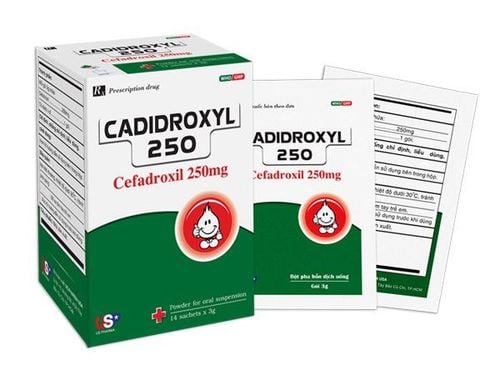This is an automatically translated article.
Bronchopneumonia is an infection of the bronchi and lung parenchyma, which can be caused by viruses, bacteria or fungi. This is one of the leading causes of death, especially bronchopneumonia in children under 5 years of age.
1. What is bronchopneumonia?
The bronchi are the airways that connect the trachea to the alveoli (also known as the lung parenchyma). The large bronchi further divide into many small airways called bronchioles, which combine with the alveoli to form the lungs. The alveoli are where the exchange of oxygen and carbon dioxide takes place between the lungs and blood vessels.So what is bronchopneumonia? Bronchitis is an infection that affects both the bronchial structures and the alveoli inside the lungs. This disease is characterized by localized inflammation around the bronchi and can affect one or more lobes of the lung at the same time.
Bronchitis will impair lung gas exchange function, which in turn leads to breathing problems. In severe cases, bronchopneumonia can develop into abscesses (or pus-filled sacs) inside the lung parenchyma. In addition, the infection, if not controlled appropriately, can spread to adjacent sites of the pleural cavity or cause sepsis affecting the whole body.
According to statistics, bronchitis in children under 2 years old accounts for more than 85% of all respiratory system diseases. The incidence of this respiratory disease infection is also very high in the elderly, especially patients over 65 years old.
2. What is the cause of bronchopneumonia?
The most common cause of bronchopneumonia is caused by bacteria, including Staphylococcus aureus (Staphylococcus aureus), Klebsiella pneumoniae, Streptococcus pneumoniae (pneumococcal), Haemophilus influenzae type B (Hib). , Pseudomonas aeruginosa (green pus bacillus), Acinetobacter baumannii...
In addition, bronchopneumonia can also be caused by a virus or a fungus with a low rate but the level of danger seems to be more serious. One of the causes of the recent global pandemic is the SARS-Cov-2 virus or the fungus Aspergillus fumigatus, which can both lead to severe bronchitis.
The causative agent of bronchopneumonia is very contagious, the main route of transmission is respiratory. Normally, when a person with bronchitis coughs or sneezes, they will create countless tiny particles with pathogens mixed into the air, thereby spreading to others at close range when they inhale.
After a person inhales respiratory droplets containing pathogens, the causative agent will reside in the nasopharynx or pharynx, when favorable conditions will penetrate deeper into the respiratory tract to the bronchi , alveoli and begin to grow to cause disease. The symptoms of bronchopneumonia occur in part because the body's immune system attacks inflammatory agents when they enter.
3. What are the risk factors for bronchopneumonia?
Some of the following risk factors can facilitate bacterial, viral or fungal growth and lead to bronchopneumonia:
Children under 2 years of age are the most susceptible to bronchopneumonia; Elderly people over 65 years old; People who have a long-term habit of smoking cigarettes or using alcohol excessively; Patients who have previously used antibiotics are at high risk of developing bronchopneumonia; The patient has had surgery or a recent major trauma; Patients with upper respiratory tract infections (such as colds and flu) are at risk of developing bronchopneumonia; Patients with a history of chronic respiratory diseases such as COPD, cystic fibrosis, bronchiectasis and bronchial asthma; History of other comorbidities such as diabetes, heart failure, liver failure; Patients with weakened immune systems, such as HIV infection or autoimmune disorders; The patient is being treated for another medical condition with drugs that suppress the immune system (such as cancer chemotherapy, anti-rejection drugs, or corticosteroids). In these cases, it is necessary to practice precautions to avoid infection, especially when having contact with people with bronchopneumonia because it is very easy to infect pathogens.
4. Diagnosis of bronchopneumonia
4.1. What are the symptoms of bronchopneumonia? Bronchitis presents with different symptoms depending on the degree of infection, age and comorbidities of the patient... Especially symptoms of bronchopneumonia are often more severe in people with immune systems. weak immune system such as young children, the elderly, people with immunocompromised diseases or taking immunosuppressive drugs.
Symptoms of bronchopneumonia may include:
Fever is a characteristic symptom of infectious diseases; Muscle pain, headache may be caused by a viral agent; Shortness of breath; Coughing up phlegm, sometimes coughing up blood; Systemic symptoms such as sweating, dizziness, tremor, chills, decreased appetite, nausea, vomiting; Some patients with bronchitis may experience weakness, fatigue, or chest pain (which may be aggravated by coughing or deep breathing; infection and respiratory failure may cause confusion or loss of consciousness). Patients with symptoms suggestive of bronchitis as above will be examined by a doctor and confirmed by the appointment of laboratory tests A suitable screening test is as follows:
Chest X-ray or CT scan: These imaging tools allow the doctor to see the structures inside the lungs, thereby checking for signs of damage from a bronchial infection and alveoli; Blood tests: Results of blood tests that can help doctors determine if a patient has an infection, such as an abnormally high white blood cell count; Bronchoscopy : By using a tube A small light with a camera attached to it to pass through the windpipe and down into the lungs will help the doctor see the structure inside and determine if there is an infection. i sputum culture: This test allows the doctor to determine exactly what the cause of bronchopneumonia is; Blood oxygen measurement or arterial blood gas test: These tests help assess the severity of respiratory failure caused by bronchopneumonia.
5. Treatment of bronchopneumonia
Mild bronchitis can be treated at home by a doctor, but severe cases or complications require inpatient treatment at the hospital. Treatments for bronchitis depend on the causative agent (bacterial, viral or fungal) and the severity of the infection. If there are no other health problems, after receiving appropriate treatment, patients usually recover within 1-3 weeks.
Specific treatment regimen for bronchopneumonia is as follows:
Bacterial bronchitis: Antibiotics are specific treatment drugs due to their ability to destroy harmful bacteria in the lungs. Patients need to strictly follow the doctor's instructions on the dose and duration of antibiotic use; Viral bronchopneumonia: Antibiotics are not effective in this case unless accompanied by bacterial superinfection. Your doctor may prescribe antiviral drugs or just symptomatic medication because viral infections usually clear up in 1-3 weeks; Fungal bronchopneumonia: Your doctor may prescribe the right antifungal medication, along with rest, and reasonable symptomatic treatment.
6. Is bronchitis dangerous?
Bronchopneumonia if not treated appropriately can easily lead to complications, especially bronchopneumonia in children, the elderly and patients with weakened immune systems. Because it is a disease in the airways, bronchopneumonia can cause respiratory failure and even affect the patient's life.
People with bronchopneumonia are at risk of experiencing the following complications:
Respiratory failure : Occurs when the exchange of oxygen and carbon dioxide in the lungs is impaired, sometimes patients with respiratory failure need to use ventilator for support; Adult acute respiratory distress syndrome (ARDS): ARDS is a severe and life-threatening form of respiratory failure; Sepsis: The causative agent of bronchopneumonia can spread into the bloodstream and lead to sepsis, which in turn damages other organs in the body and leads to multi-organ failure and life-threatening; Lung abscess: Untreated pneumonia increases the risk of pus pockets (or abscesses) forming inside the lungs. In summary, bronchopneumonia can lead to many dangerous complications and is one of the leading causes of death in children under 5 years of age. Understanding the causes and symptoms will help improve treatment effectiveness and minimize dangerous complications of the disease.
Please dial HOTLINE for more information or register for an appointment HERE. Download MyVinmec app to make appointments faster and to manage your bookings easily.













